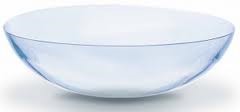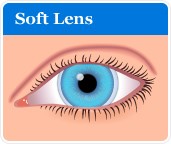Soft contact lenses
Soft contact lenses are mainly used for the correction of all refractive anomalies. Moreover they are also used for cosmetic and therapeutic purposes.


Soft contact lenses are mainly used for the correction of all refractive anomalies (myopia-shortsightness, hyperopia-longsightness, astigmatism-blurred vision, presbyopia-age related loss of close-up vision). Moreover they are also used for cosmetic and therapeutic purposes.
Soft contact lenses are used by the vast majority of contact lens wearers worldwide. This is mainly because of the unbelievable comfort that they provide to the wearer. They are so comfortable because of their texture and their size. They have a soft, foldable, almost cling film like texture and they have an average diameter of 14mm. Their diameter means that soft contact lenses are actually larger than your cornea (outermost transparent tissue of the eye where your contact lenses rest), so their edge actually rests on the sclera which is the white part of the eye. Because of their diameter, soft contact lenses ‘tuck under’ the eyelids and as a result you don’t feel the lens edges every time you blink.
There is only a slight eyelash like sensation present during the very first application of a soft contact lens into an eye which only lasts for a few seconds. This sensation very quickly disappears and actually NO sensation should be present when routinely using soft contact lenses. Being very thin and having their soft texture, they gently rap around the front of your eye, conforming its shape. Even though soft contact lenses move very slightly inside your eye (less than 0.5 of a mm) every time you blink (and this movement is essential and desirable for tear exchange behind the lens), they almost never decenter or come out of the eye. That is the reason why soft contact lenses are the type of choice if you participate in sports or if you simply lead an active lifestyle.
The form of soft contact lenses has dramatically over the last few decades and their use is as versatile now than ever before. Soft contact lenses can be divided in different basic categories based on how they are worn or what they are made of:
| for how long can I use the some pair of contacts? | what are my contacts made of and why? |
| Disposable-Dailies | Hydrogels |
| Frequent replacement e.g: monthlies | Silicone hydrogels |
| Extended wear |
Disposable daily soft contact lenses remain unfortunately the most expensive option but they are the simplest and most convenient option if you don’t want to bother with lens solutions and cases. That is because you insert them in the morning, you wear them for the day and you simply discard them in the evening. Actually the only thing that you need to do is to wash and dry your hands thoroughly just before you insert them in the morning and just before you remove them in the evening. In other words you don’t need to clean or disinfect them. The fact that with a daily regime, you always apply a new/fresh lens into your eye, means that dailies remain the best option if you suffer with seasonal allergies. Dailies are very thin and comfortable in the eye and do carry the lowest risk of eye infections because of all mentioned above.
If you are considering the cost of dailies in comparison to monthly lenses, you might consider daily disposable lenses if you only wear contact lenses occasionally. However, daily lenses are much cheaper compared to when they initially became available. More specifically they nowadays cost about the same as frequently replacement monthly lenses if they are only used twice a week for example involvement in your favorite sport activity (10 times a month to be exact).
Frequently replacement soft contact lenses are simply worn for the recommended timeframe from the manufacturer such as weekly, fortnightly or monthly. Monthly replacement soft contact lenses are typically the least expensive option for you. You insert them in the morning, wear them for the day and you remove them in the evening. Upon removal you clean them and then soak them in your solution in your lens case in order for the disinfection to take place overnight. It is very important to follow simple steps for the care of your monthly lenses in order to minimize the risk of eye infections. We do know for certain that about 80% of eye infections in contact lens wearers are initiated from poor case hygiene. Yearly replacement contact lenses are nowadays very rarely dispensed and are actually almost completely unavailable from manufacturers worldwide. They are of course not considered to provide frequent replacement regimes and where still used, wearers should prefer hydrogen peroxide solution systems, the later accompanied with the important instructions for safe use.
Extended wear soft contact lenses should not really be used lightly hearted but only if necessary. Some types of silicone hydrogel soft contact lenses have been approved for extended wear use and that means that you can wear them while you sleep. It is important to know that great cautious should be exercised with overnight use of contact lenses since it increases considerably the risk of eye infections. This occurs mainly because of the reduced oxygen supply to the cornea. If an extended wear regime is unavoidable, the user should know that the lenses must be removed for cleaning and disinfecting at least once week.
Hygrogel soft contact lens materials Vs Silicone Hydrogel soft contact lens materials
Silicone hydrogel materials have been introduced into the contact lens market in the late 1990’s. Compared to their hydrogel predecessors, silicone hydrogels provide greatly improved oxygen supply to the cornea and thus believed to generally allow longer contact lens wear with improved comfort. There are actually many types even generation of silicone hydrogel materials. They most certainly allow better oxygen supply or breathability to the cornea compared to regular hydrogel contact lenses. This means that their use reduces complications to the cornea which are related with the starving of the later from oxygen. The elimination of such problems should have long term health benefits for the eyes, allowing longer wearing times by keeping your eyes whiter and healthier.
However, the incorporation of siloxane components into conventional hydrogel materials may create wettability issues and the built up of certain lipids on to lens surface in certain wearers with marginal tear production/tear gland dysfunction, although this remains to be confirmed.


